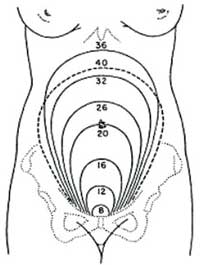Changes in the uterus, cervix and vagina
The uterus
After conception, the uterus provides a nutritive and protective environment in which the fetus will grow and develop. It increases from the size of a small pear in its non-pregnant state to accommodate a full-term baby at 40 weeks of gestation. The tissues from which the uterus is made continue to grow for the first 20 weeks, and it increases in weight from about 50 to 1,000 gm (grams). After this time, it doesn't get any heavier, but it stretches to accommodate the growing baby, placenta and amniotic fluid. By the time the pregnancy has reached full term, the uterus will have increased to about five times its normal size:
- In height (top to bottom) from 7.5 to 30 cm
- In width (side to side) from 5 to 23 cm
- In depth (front to back) from 2.5 to 20 cm.
What causes these changes?
At 12 weeks' gestation (near the end of the first trimester, i.e. three-month period), the fundus (upper margin of the body of the uterus) may be palpated (felt) through the abdomen above the pubic bone (symphysis pubis). The size of the uterus usually reaches its peak at about 36 weeks' gestation (see Figure 7.1).

After how many weeks of pregnancy can the fundus be palpated at the height of the woman's umbilicus (belly-button), according to Figure 7.1?
The uterus may drop slightly as the fetal head settles into the pelvis, preparing for delivery. Notice the position at 40 weeks of gestation, which is shown as a dotted line in Figure 7.1. This dropping is referred to as 'lightening'. It is more noticeable in a primigravida (pregnant for the first time) than in a multigravida (a woman who has been pregnant previously, regardless of outcome).
The cervix
The cervix remains 2.5 cm long throughout pregnancy. In late pregnancy, softening of the cervix occurs in response to increasing painless contractions of its muscular walls.
The vagina
The vagina also becomes more elastic towards the end of pregnancy. These changes enable it to dilate during the second stage of labour, as the baby passes down the birth canal. (You will learn all about this in the next Module on Labour and Delivery Care.)